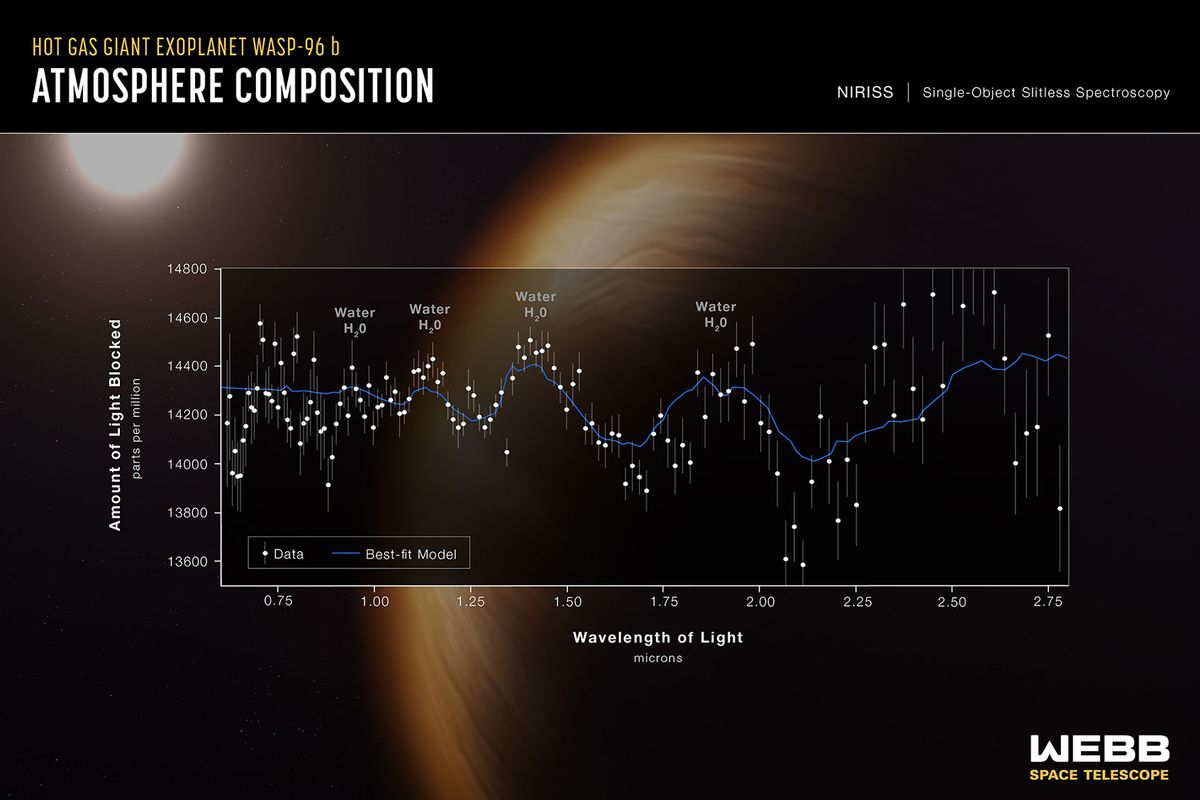The James Webb Telescope has already found previously-undetected water on a distant planet

On Tuesday, a team of NASA astronomers revealed the first much-anticipated images taken by the groundbreaking James Webb Space Telescope (JWST).
From a full infrared image of the distant universe to a dazzling image of the Carina Nebula, the world was not disappointed. Besides the awe-inspiring images, Earthlings got a sneak peek into the kind of science JWST will be conducting as it searches for habitable exoplanets in the universe. Indeed, astronomers revealed the most detailed measurements of an exoplanet’s atmosphere outside of our solar system to date — and it appears that there are indications of water, haze and clouds in the planet’s atmosphere that weren’t previously known.
RELATED: Astronomy doubles down on search for ET
The observed exoplanet in question is named WASP-96b, and it is one of the more than 5,000 planets that have been confirmed to exist in the Milky Way galaxy outside of our own solar system to date. Cataloguing and discovering exoplanets, meaning planets in other solar systems, is an impressive human achievement: because they are so much smaller than stars, and thus so much fainter, they are far harder to see. In fact, the first exoplanet wasn’t detected until 1992 — meaning that any science fiction produced prior to then that involved explorers visiting other planets was based on speculation.
The exoplanet WASP-96b is located nearly 1,150 light-years away in the Phoenix constellation, and was first discovered by scientists in 2014. It is a fairly unusual exoplanet, as there is no comparable planet to it that exists in Earth’s solar system. For example, WASP-96b orbits its own star every 3.4 days, which means temperatures hover around 1,000 degrees Fahrenheit. (For comparison, Mercury, the closest planet to our sun, orbits once every 88 days. Also, our solar system has no gas giants that are close to the sun.)
As a gas planet that’s less than half the size of Jupiter (but has a diameter 1.2 times greater than Jupiter), NASA describes WASP-96 b as being “much puffier” than any planet orbiting our Sun.
Want more health and science stories in your inbox? Subscribe to Salon’s weekly newsletter The Vulgar Scientist.
Extraordinarily, from only 6.4 hours of observation, JWST took incredibly precise measurements of the exoplanet that revealed a distinct signature of water, and evidence of haze and clouds. Previous studies of WASP-96b didn’t detect such signatures.
The measurements, which are the most detailed of their kind, were made by JWST’s Near-Infrared Imager and Slitless Spectrograph (NIRISS), which measured light from the exoplanet as it passed by its star. The light curve showed a change in brightness and individual wavelengths of infrared light between 0.6 and 2.8 microns.
The measurements also revealed a hidden albeit somewhat familiar atmosphere, one with an “unambiguous signature of water, indications of haze, and evidence of clouds that were thought not to exist based on prior observations.”
“From our viewing angle, this transits in front of its star every three and a half days, allowing a small fraction of the star’s light to pass through its atmosphere and reveal its composition,” Avi Loeb, the former chair of the astronomy department at Harvard University, explained to Salon via email. “Such measurements help us to better understand how gas giants in the solar system formed. “
The measurements confirmed some of what scientists already knew: the size, orbit, and mere existence of WASP-96b. But as previously stated, it also revealed a hidden albeit somewhat familiar atmosphere, one with an “unambiguous signature of water, indications of haze, and evidence of clouds that were thought not to exist based on prior observations,” as NASA explained.
So, does that mean that life could exist on this exoplanet? Water is considered a key signature of life beyond Earth, after all.
“Such planets are not thought to host life, because they do not possess a thin atmosphere on top of a rocky surface, like Earth does,” Loeb explained. “The combination of liquid water and a solid surface are thought to be crucial ingredients in the recipe for ‘life as we know it.'”
However, the measurements give the world a preview of how accurately and quickly JWST might be able to fulfill its mission of surveying the atmospheres of Earth-like exoplanets. As previously reported, JWST might even be capable enough to observe industrial pollution in an alien planet’s atmosphere, too — revealing intelligent alien civilizations, extinct or still existing.
NASA said the next step for JWST is to “measure the amount of water vapor in the atmosphere, constrain the abundance of various elements like carbon and oxygen, and estimate the temperature of the atmosphere with depth.”
“They can then use this information to make inferences about the overall make-up of the planet, as well as how, when, and where it formed,” NASA stated.
Read more
on astronomy:

